Robot Monster
3 /10 1 Votes
31% Rotten Tomatoes Genre Horror, Sci-Fi Country US | 2.9/10 IMDb Budget 16,000 USD Duration Language English | |||||||||||||||||||||||||||||||||
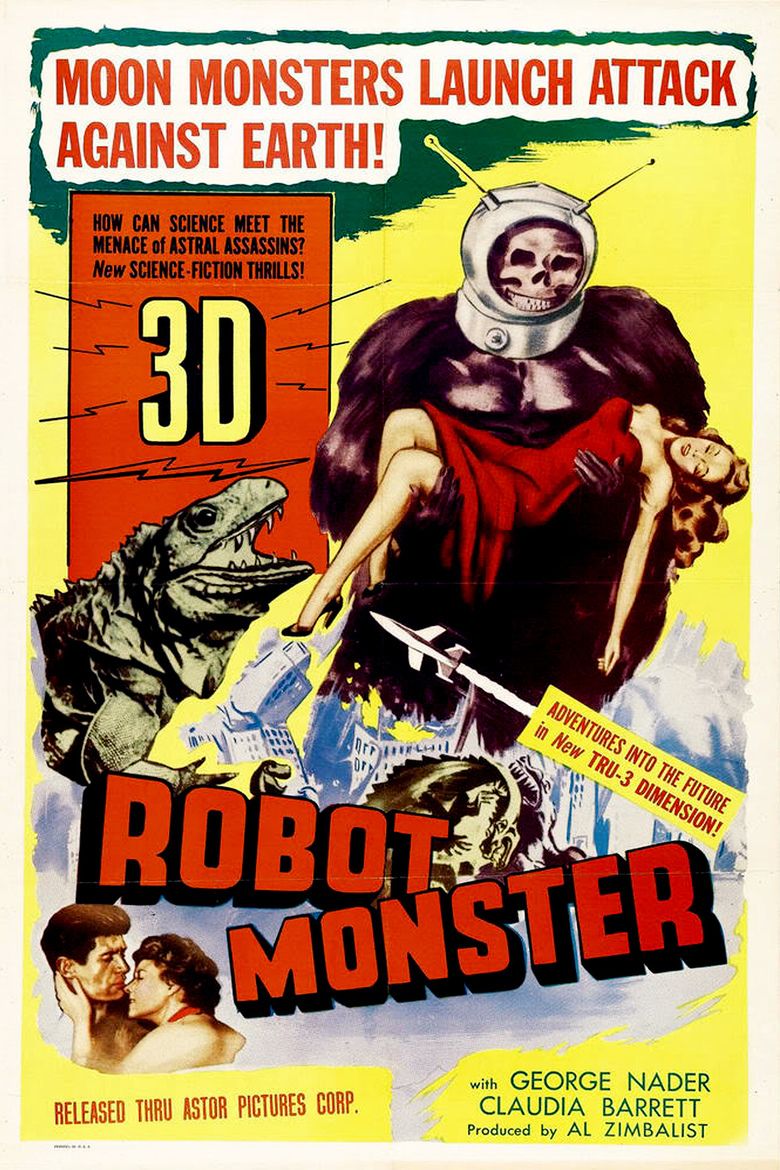 | ||||||||||||||||||||||||||||||||||
Release date June 24, 1953 (1953-06-24) Writer Wyott Ordung (original screenplay) Cast (Roy), (Alice), (Mother (as Selena Royale)), (The Professor), Gregory Moffett (Johnny), Pamela Paulson (Carla)Similar movies Interstellar , Big Hero 6 , Chappie , Ex Machina , Project Shadowchaser II , WALL·E Tagline Moon monsters launch attack against Earth! How can science meet the menace of astral assassins? New Science Fiction Thrills! | ||||||||||||||||||||||||||||||||||
Robot monster 1953 trailer
Robot Monster (a.k.a. Monster from Mars) is a 1953 independently made American black-and-white 3D science fiction film, produced and directed by Phil Tucker, written by Wyott Ordung, that stars George Nader, Claudia Barrett, and George Barrows. The production company was Three Dimension Pictures, Inc. The film was distributed by Astor Pictures.
Contents
- Robot monster 1953 trailer
- Plot
- Production
- 3D
- Special effects
- Film score
- Release
- Reception
- Aftermath
- In popular culture
- References
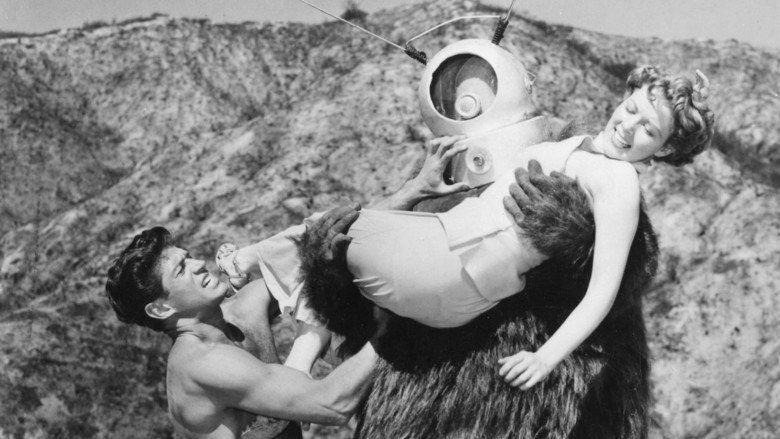
Robot Monster tells the story of Moon robot Ro-Man's mission to Earth to destroy humanity. He manages to kill all but eight survivors, who have become immune to his death ray. Ro-Man runs afoul of the Great Guidance, his leader, when he becomes attracted to the human Alice. She is the eldest daughter of a surviving scientist, and he refuses to harm her. The Great Guidance must now finish what the Moon robot started.
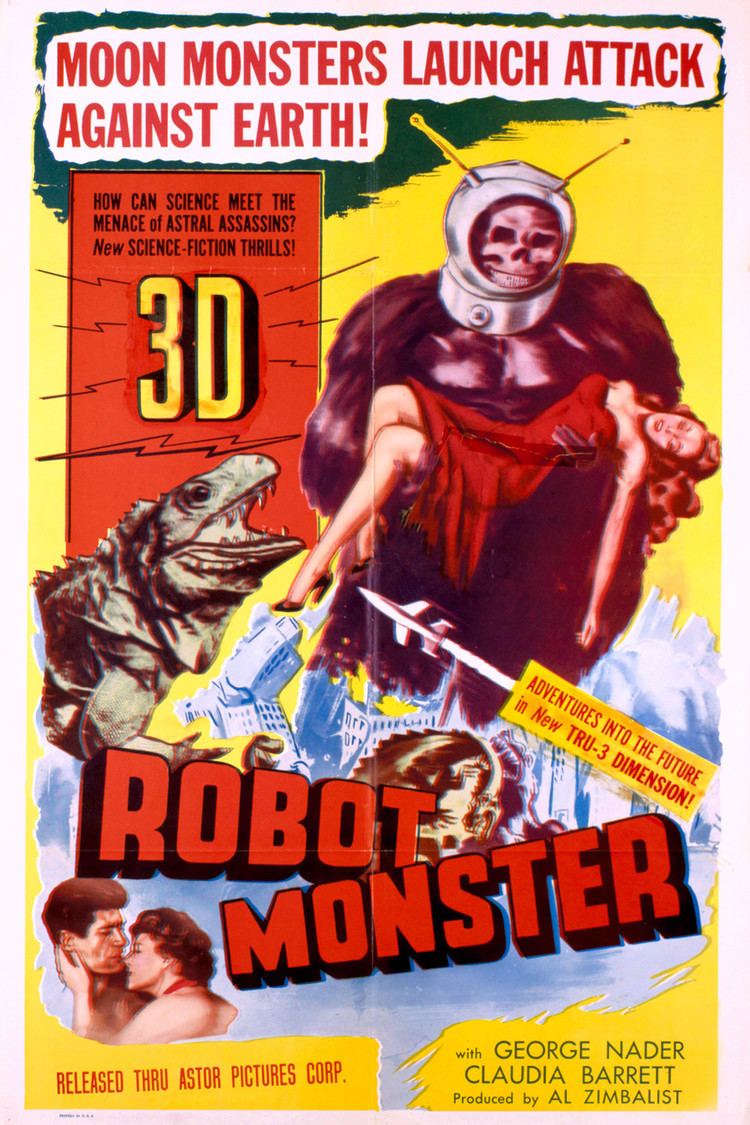
Plot

Evil Moon robot Ro-Man Extension XJ-2 (Barrows), referred to as just Ro-Man, has seemingly destroyed all human life on Earth with a Calcinator death ray, all except for eight humans that remain alive. The survivors are an older scientist (John Mylong), his wife (Selena Royle), his two daughters, his young son Johnny (Gregory Moffett), his assistant, and two space pilots that shortly take off in a spaceship for an orbiting space platform. All eight have now developed an immunity to Ro-Man's death ray, having received an experimental antibiotic serum developed by the scientist.
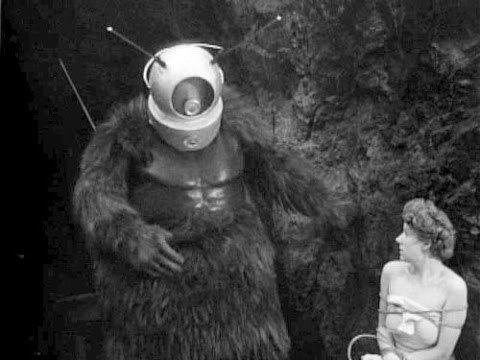
Ro-Man must complete the destruction of all humans, even if it means his physically killing them one by one, before his mission to subjugate the Earth is complete. After fruitless negotiations, Ro-Man, with a laser in hand, destroys the spaceship headed for the orbiting platform, killing the two pilots aboard. He later strangles the youngest daughter, Carla (Pamela Paulson), and tosses the assistant scientist, Roy (Nader), to his death over a cliff.
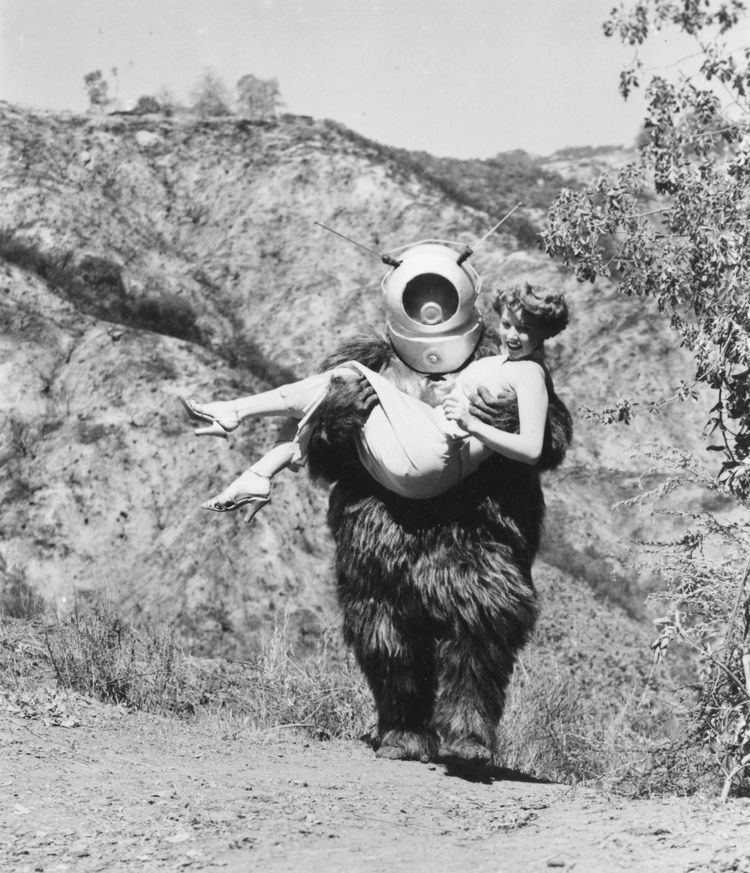
Ro-Man's mission is waylaid, though, when he develops an illogical attraction to Alice (Barrett), the scientist's eldest daughter. He refuses to eliminate her, forcing the alien leader, the Great Guidance, to teleport to Earth after first killing the disobedient Ro-Man. The Great Guidance then attempts to finish the genocide by releasing prehistoric dinosaurs and a massive earthquake on the remaining survivors.

But Johnny is alive, having just awoken from a concussion-induced fever dream. Up to now, all that has happened has just been his nightmare. His parents, who had been looking for him, rejoice and take him home.
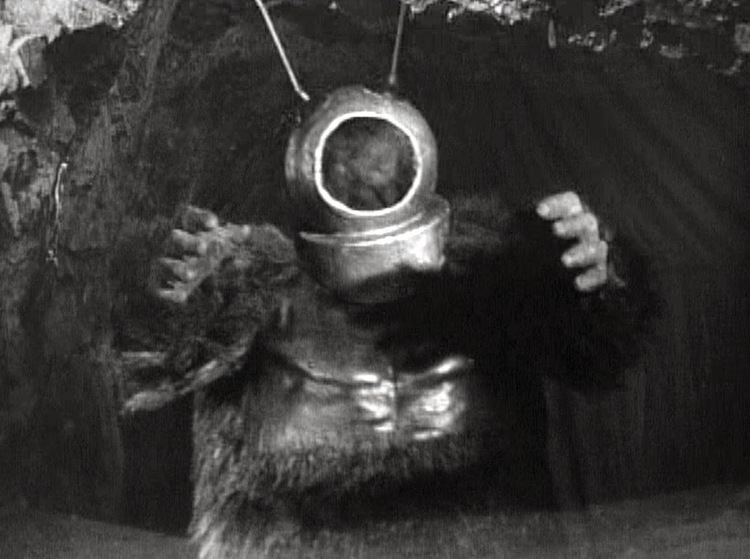
Suddenly, Ro-Man, his arms raised in a threatening manner, rushes out of a cave.
Production
Twenty-five-year-old writer/director Tucker made Robot Monster in four days for an estimated $16,000. Except for a few scenes at a house in Los Angeles and a building site near Dodger Stadium, most footage was filmed outdoors in Bronson Canyon, the site of innumerable motion pictures and TV settings. Principal photography on Robot Monster wrapped on March 23, 1953.
Robot Monster's very low budget did not allow for a robot costume as first intended, so Tucker hired his friend Barrows, who had made his own gorilla suit, to play Ro-Man; Tucker then added the space helmet. Nightclub comic Slick Slavin reportedly filmed an opening prologue for the movie.
Robot Monster is similar in its plot to Invaders from Mars, released a month earlier by 20th Century Fox. Both films contain a young boy stumbling upon an alien invasion who is captured as he struggles to save his family and himself. As the alien commences the final destruction of Earth, the boy awakens to find it was all a dream. Barrett recalled in an interview that the film's original screenplay was designed as reality, but director Tucker changed his mind and then shot a new twist ending that showed the film's story has been a boy's dream that is about to come true.
In Robot Monster's opening credits, "N. A. Fischer Chemical Products" is given prominent credit for the "Billion Bubble Machine", used as part of Ro-Man's communication device for reporting to his superior, the Great Guidance.
3D
Robot Monster was shot and projected in dual-strip, polarized 3D. The stereoscopic photography in the film is considered by many critics to be of a high quality, especially for a film whose crew had little experience with the newly developed camera rig. Producer Al Zimbalist later told The New York Times that shooting the film in 3D (which involved using another camera) added an extra $4,510.54 to the budget.
Special effects
Robot Monster's special effects include stock footage from One Million B.C. (1940), Lost Continent (1951) and Flight to Mars (1951); a brief appearance of the Rocketship X-M (1950) spaceship boarding; and a matte painting of the ruins of New York City from Captive Women (1952).
Film score
Robot Monster's music score was composed by Elmer Bernstein, who also composed Cat Women of the Moon the same year, and later, the more prestigious The Great Escape, The Magnificent Seven, The Ten Commandments and Michael Jackson's Thriller music video.
Bernstein recalled he was stuck in a period where he was "greylisted" because of his left-wing politics and only offered minor films, but said he enjoyed the challenge of trying to help a film. Ordung stated that Bernstein scored the film with an eight-piece orchestra, and Capitol Records expressed interest in producing an album.
Release
Robot Monster was released by Astor Pictures on June 24, 1953, at a runtime of 62 minutes.
Reception
Robot Monster was originally released with the 3 Dimensional Pictures short Stardust in Your Eyes, starring nightclub comedian Trustin Howard as Slick Slaven. In December 1953, the Los Angeles Times reported that "theater men" considered the film "one of the top turkeys of the year".
The film is frequently considered one of the worst movies ever made. Film historian Leonard Maltin called it "one of the genuine legends of Hollywood - embarrassingly, hilariously awful...just dig that bubble-machine with the TV antenna".
The movie was included as a selection in the 1978 book The Fifty Worst Films of All Time (And How They Got That Way). Robot Monster currently holds a 31% approval rating at the film review aggregator website Rotten Tomatoes, based on 13 reviews, with an average rating of 3.8 out of 10.
Despite rumors to the contrary, the film received some decent reviews, and it grossed $1,000,000 during its initial release, more than 62 times its original investment. The film was soon sold to television, where its infamy slowly spread to new generations of cult movie fans.
The Los Angeles Times called it "a crazy mixed up movie ... even children may be a little bored by it all". The review in Variety noted, "Judged on the basis of novelty, as a showcase for the Tru-Stereo Process, Robot Monster comes off surprisingly well, considering the extremely limited budget ($50,000) and schedule on which the film was shot".
Aftermath
In December 1953, it was reported that Tucker tried to commit suicide at the Los Angeles Knickerbocker Hotel. He was only saved because he had written a suicide letter and sent it to a newspaper, who sent a reporter and some detectives to the hotel. He was discovered with a pass in his pocket from the psychopathic ward of the Veterans Affairs Hospital. In the letter, Tucker said he had not been paid for Robot Monster and was unable to get a job. "When I was refused a job - even as an usher," Tucker wrote, "I finally realized my future in the film industry was bleak". It was revealed that Tucker and the producer had quarreled, and film exhibitors had instructions not to let Tucker in to see the film unless he paid admission.
In Keep Watching the Skies!, a comprehensive history of 1950s and early 1960s American science fiction films, author Bill Warren claimed that Tucker's attempted suicide was due to depression and a dispute with the film's distributor, who had allegedly refused to pay Tucker his contracted percentage of the film's profits.
The actors connected to Robot Monster included George Nader, who won the Golden Globe in 1954 as "Most Promising Male Newcomer of the Year" (although his award was not tied to his Robot Monster performance). He signed with Universal Studios, where he starred only in secondary features; other new male stars, like Tony Curtis and Rock Hudson, were assigned to major film roles.
Selena Royle, an MGM stock player, had a durable film career beginning in 1941, but it ended in 1951 when she was branded a Communist sympathizer. She refused to appear before the House Committee on Un-American Activities and eventually cleared her name. By then the damage to her reputation had already been done; she made only two additional films, Robot Monster being her last.
In popular culture
Robot Monster was featured in a 1986 episode of the Canned Film Festival, and a 1989 episode of Mystery Science Theater 3000.
A brief scene from the film can be seen in the music video for the Cars' single "You Might Think".
Ro-Man is seen in the 2003 film Looney Tunes: Back in Action.
Ro-Man was the inspiration for the fictional monster SCP-2006, from the SCP Foundation online writing community, which launched in 2008.
In the 2010 animated film Megamind, the character Minion (voiced by David Cross) resembles Ro-Man, with the body of a gorilla and a transparent head with a fish in it.
References
Robot Monster WikipediaRobot Monster IMDbRobot Monster Rotten TomatoesRobot Monster themoviedb.org
